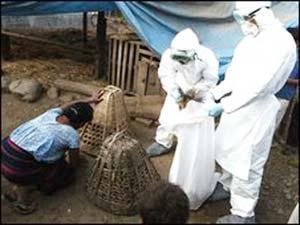Source: Xinhua
02-16-2009 14:51
Special Report: Tech MaxKATHMANDU, Feb. 15 (Xinhua) -- Though Nepal has successfully controlled the first outbreak of bird flu (H5N1), it is at high risk of recurring outbreaks, said Prabhakar Pathak, Director General of the Department of Livestock Services in Kathmandu.
 |
| Though Nepal has successfully controlled the first outbreak of bird flu (H5N1), it is at high risk of recurring outbreaks. |
In an interview with Xinhua, Pathak said, "Open border has created heedful circumstances in Nepal to be affected by bird flu at any time."
The high-ranking governmental officer Pathak said that Nepal saved itself for three years after neighboring country India were affected by bird flu since 2006.
"We are so amazed by the way we saved ourselves when our close and open bordering neighbor got this virus in 2006," Pathank added.
"No matter how hard we try to prohibit the transferring of poultry goods and birds, because of the open border, there is more probability of birds migrating from affected areas of other countries."
By now more than 67 countries in the world are affected by this virus, and Nepal, a landlocked country surrounded by affected countries, is at high risk of more outbreaks, according to Pathak.
However, he also assured that there is no risk from China since Nepal does not have any poultry related trade with China.
"We are not in such violent dangerous condition comparing to other countries," said Pathak. In other countries when the virus outbroke in one spot it is gradually followed by a number of other spots. But in Nepal's context, it is able to control the disease on the spot where it was first seen when no human has been affected by this virus, he said.
Nevertheless, he stressed that Nepal is in high risk as it is largely locked by affected countries. "If the disease outbreaks inmore than three places then we are not able to control as we did in Jhapa district," said Pathak.
According to him, if the disease would have been outbreak in the capital Kathmandu or Chitwan district which is also call capital of poultry farming, then the situation would have gone more serious and disastrous.
"Currently we are making plans, we have strategy and simultaneously we are even training our manpower. In the same manner we are furnishing our labs and quarantine. But if the disease shatters in more than two places then our resources and manpower is inadequate", Pathak said.
"We are in critical shortage of manpower especially veterinarian," he added.
According the Pathak, Nepal lacks high power spray, campaign equipment, communication equipment for mass awareness, and warehouse. If the disease is shown for more places then Nepal government do not have sufficient store.
"Unorganized farm and open border is adding the problem, so the reason we need to be alert" he said. "We need to be prepared, cautious and well equipped for the possible outbreaks of the disease in the other parts too," Pathak added.
Furthermore, he said that there is a birds gathering place called "Tagantubba" in Jhapa district in eastern Nepal, which is only 3 km from Indian border where various kinds of birds that come from India and elsewhere outside from the Nepali border. Fromthere, these birds travels to many other parts of the country.
"We declared it as 'hot spot' and sealed the place and culled all the birds in our reach. Likewise there are many other places very close to India and other affected countries which alerts us from recurring outbreak of this virus again and again," Pathak said.
Though Nepal is cautious to care not to allow any affected birds from neighboring countries, nevertheless, Nepal alone can not stop migrant birds flying toward Nepal during the winter.
Nepali government has kept this disease in high priority as well labeled as natural calamities and negotiating with donor agencies for aid.
"Unless the disease get eliminated from the close neighboring countries, we can't breath sigh of relief, rather are in high alert," Pathak said.
Due to this reason, four members experts Crisis Management Center from Food and Agriculture Organization of the United Nations are in Nepal to learn the situation. They are evaluating Nepal's technical, administration sector and logistics ability, according to him.
"We can get guidance from them, Pathak added."
On Jan. 16, Nepali government for the first time confirmed the outbreak of bird flu virus in Jhapa district (bordering to neighboring country India), some 320 km southeast of Nepali capital Kathmandu and issued a bird flu alert in the area.
Pathak even assured that team has not culled out any endangered species of birds during the process of controlling disease besides of chickens, ducks pigeons and parrot.
"We culled every possible birds we could reached especially domestic birds, but we left the wild species because we could not capture them, on top of that there is less chance of virus being transferred from wild birds."
Nepal rated 26 districts in southern plain in very high alert area which are very close to Indian border, after disease got reappeared in West Bengal of India since December 16, 2008.
As many as 23,947 chickens, 4,931 eggs, 329 pigeon, 401 ducks, 345 feed, 1,009 egg crate, 12 parrot and other birds were destroyed in Jhapa district during the process to control the disease. A total of 1,166 poultry and 278 eggs were destroyed in suspicious zones close to Indian border, according to Pathak.
-- Click for more news in Tech Max >>
Editor:Yang Jie
